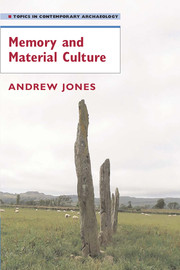Book contents
- Frontmatter
- Contents
- Preface
- 1 Memory and Material Culture?
- 2 From Memory to Commemoration
- 3 People, Time, and Remembrance
- 4 Improvising Culture
- 5 Continuous Houses, Perpetual Places: Commemoration and the Lives of Neolithic Houses
- 6 Culture, Citation, and Categorisation: Regionality in Late Neolithic Britain and Ireland
- 7 Chains of Memory: The Aesthetics of Memory in Bronze Age Britain
- 8 The Art of Memory: Memory, Inscription, and Place
- 9 Tracing the Past: Landscape, Lines, and Places
- 10 Coda
- References
- Index
7 - Chains of Memory: The Aesthetics of Memory in Bronze Age Britain
Published online by Cambridge University Press: 07 December 2009
- Frontmatter
- Contents
- Preface
- 1 Memory and Material Culture?
- 2 From Memory to Commemoration
- 3 People, Time, and Remembrance
- 4 Improvising Culture
- 5 Continuous Houses, Perpetual Places: Commemoration and the Lives of Neolithic Houses
- 6 Culture, Citation, and Categorisation: Regionality in Late Neolithic Britain and Ireland
- 7 Chains of Memory: The Aesthetics of Memory in Bronze Age Britain
- 8 The Art of Memory: Memory, Inscription, and Place
- 9 Tracing the Past: Landscape, Lines, and Places
- 10 Coda
- References
- Index
Summary
As shown in the previous chapter, artefact categories have often been treated as ‘natural kinds’ that can be categorised in much the same way as animal and plant species. As a result archaeologists have long assumed a relatively passive relationship between artefacts and their producers. For instance, we see little attention paid to the influence one artefact has upon the producer in the production of further artefacts. Instead we prefer to classify groups of artefacts morphologically and decoratively according to their cultural affinity. One means by which archaeologists compare artefacts is through the medium of the corpus, a printed volume with illustrated examples of artefacts that can be compared one to the other, almost as clients would compare one pattern with another in the pattern books of the eighteenth century. In this chapter I argue we need to divest ourselves of the comparative approach engendered by the archaeological corpus if we are to understand how memory is reproduced in prehistory. As I show at the end of this chapter the aesthetics of memory promoted by the printed page of the corpus, and the aesthetics of memory engendered by prehistoric mortuary practices, are of a wholly different nature.
The culture-historical method provides the impulse for the creation of the corpus of artefacts. Such an approach assumes a relatively passive role for culture. The possession of culture is here assumed to have an effect upon the morphology and decoration of artefacts, and this effect is often treated as if it were passive.
- Type
- Chapter
- Information
- Memory and Material Culture , pp. 141 - 161Publisher: Cambridge University PressPrint publication year: 2007

